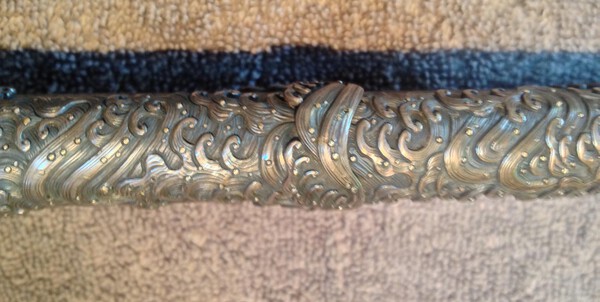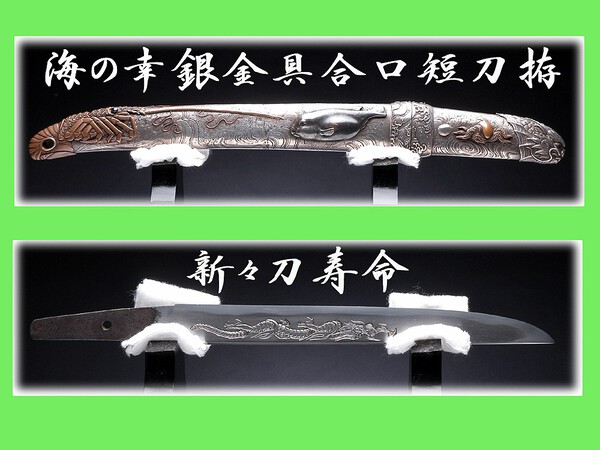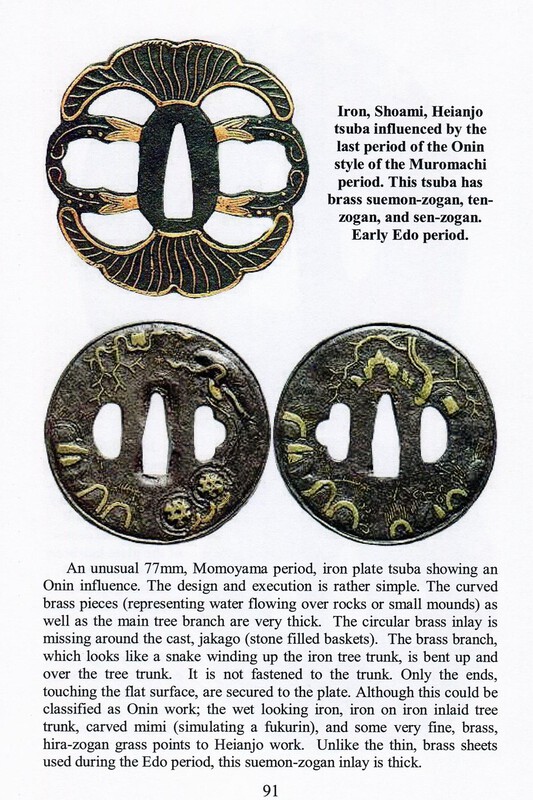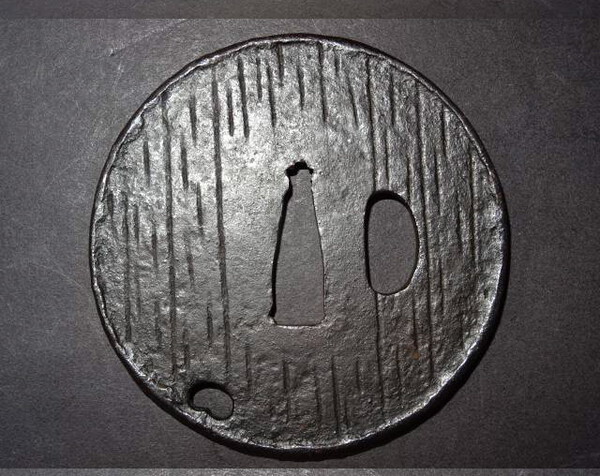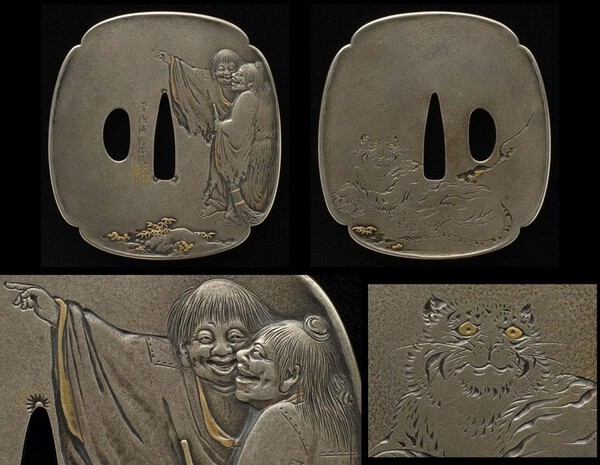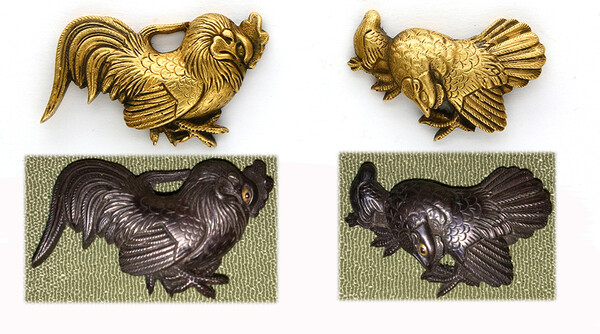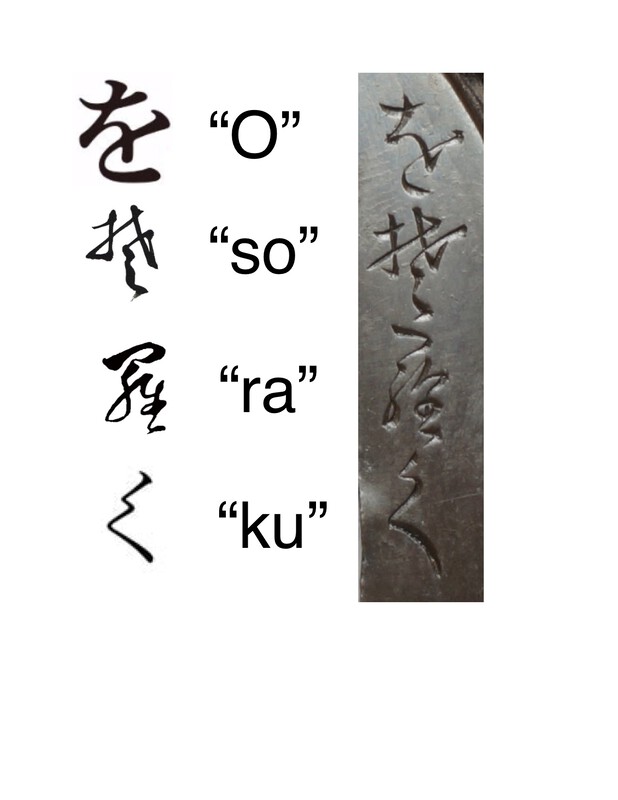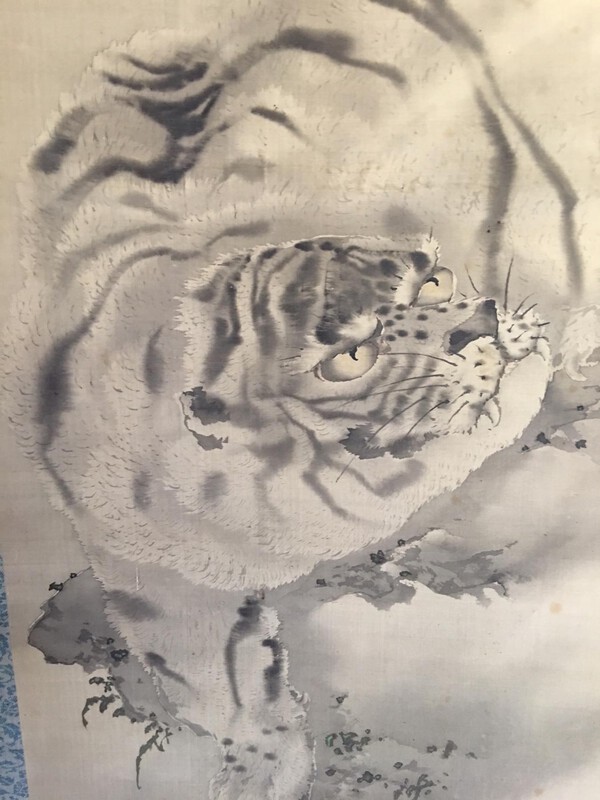-
Posts
858 -
Joined
-
Last visited
-
Days Won
7
Content Type
Profiles
Forums
Events
Store
Downloads
Gallery
Everything posted by Tanto54
-

Update On Gold Menuki From Ginza Seiyudo
Tanto54 replied to PhoenixDude's topic in Auctions and Online Sales or Sellers
Dear Jay, If they sold it to you as antique, then that's illegal fraud both in the USA and Japan (because they surely knew). -

Beware Of This Seller On Ebay
Tanto54 replied to AnAmNeSiS's topic in Auctions and Online Sales or Sellers
Shill bidding is illegal (in most developed jurisdictions - including USA). -
-
I believe that Thomas is correct. The Japanese name for the basket shaped erosion control is take-jakago. The tsuba pictured below has the exact same shapes and is described as a Jakago and is illustrated on page 91 of the book "Japanese Sword Guards - Art of War" by Gary Murtha.
-
Dear Steve, Please be fair. You say in your post #41 that "I started it" in my post #18, but the fact is that you started denigrating kinko and its proponents (look at posts #13-15). My first post (#18) was a reaction to the impropriety of those earlier posts.
-
Dear Steve, Thanks for your thoughtful reply. I applaud your attempt to help Steve appreciate iron. I just hope/wish that you could do it without denigrating kinko - he didn't request that.... It appears to me that all too often when proponents of iron extoll its virtue, they do so by putting down kinko and its proponents instead of simply talking about the values of iron (e.g., if you like iron, then you are erudite like me and the tea master, but if you like kinko, then you are like the nouveau riche, tacky warlord....)
-
Hi Barry, All of the work within the seppadai on the Shomin Tsuba is below the ground so there is no problem at all (as you may know, the Japanese aesthetic often suggests or hides part of the image - this is not uncommon on good tsuba that were actually mounted and used).
-
Dear Steve, Don’t get me wrong - I like old iron too, but I’m really tired of the “Emperor has no Clothes” elitism that we hear from some on the “hard metal” side (not saying its you...). For example, they say ridiculous things like kinko tsuba weren’t used by real samurai or were too soft to be used in battle - BS. Or they say, as you mature, you’ll “graduate” and realize how gaudy kinko is and how sophisticated iron is (i.e., see Hideyoshi vs. Rikyu comparisons - come on, that’s unfair). Sure the patina on an old, worn-out manhole cover looks great, but so does tasteful kinko. Let’s use your own example and put it next to a kinko example (that many on the “hard metal” side would say is “gaudy”). While “art” is in the eye of the beholder, you are not being honest with yourself if you cant admit that the Shomin kinko below is at least as good as your “hard metal” example. I guess that I’m just reacting to what appears to be attempts to persuade Chris by jovial elitism and embarrassment.
-
Dear Chris, Don't be ashamed of a love and appreciation of soft metal, and don't be persuaded to the "dark side" of old charcoal briquettes and manhole covers unless you really determine that you like them (I believe that there are far too many collectors who are admiring the Emperor's New Clothes...)
-
Dear Steve, I believe that this menuki represents Amenonuhoko (the jeweled spear from the Shinto creation myth) used by Izanagi-nokami and Izanami-nokami. They were brother & sister and later husband & wife Shinto deities who used Amenonukoko to stir the seas in order to create and consolidate the land mass of Japan. Their union also created many of the other famous gods like Ebisu. The combination of a Magatama and a Yari in Japanese art would be used for that representation.
-
Dear John, Believe me that I would not make these acquisitions without clear proof. You have evidentially studied the lost wax method some, but it appears that you may not have studied modern vulcanized rubber molding and the wax injection method that is often used with the modern lost wax method of casting (and did not exist 50 years ago...). If you were familiar with those techniques, you would be able to see that mine is the original and that a rubber mold was made from mine and then wax was injected into the mold allowing multiple copies of my menuki to be easily made. This is clear because the chiseling and "original defects" in mine which are clearly not molded (e.g., dents, cuts and chisel marks) are clean and sharp in mine and while they also exist on the copy, they are smoothed over and rounded (showing that they are cast instead of original cuts). In addition, casting bubbles are evident in the copies and there are none on mine. With Brian's permission, I'll try to put together a pictorial explanation of the process and some of the telltale signs of casting over the next few days. If it is useful, perhaps it can be added to the other reference materials on the NMB.
-
Dear Jay, PM sent about your menuki.
-
Dear John, If you look closely at my set, you will see finely chiseled details that do not come out clean in the molding process. In the gold set, you can see casting bubbles in a few places (but none on mine). I've been doing this for many years, and I can assure you that mine is not a cast copy but the set on Aoi is a cast copy.
-
Folks, I was shocked to see a modern, rubber molded copy made from a pair of authentic menuki that I recently purchased from Japan. See the following post and string in the Auction Section: http://www.militaria.co.za/nmb/topic/22676-aoi-auction/ Here's the auction at Aoi: http://www.sword-auction.jp/en/content/af17114-目貫:無銘雄鶏-menuki-mumeiunsignedrooster I wanted to repost my comments here to warn our Tosogu Collectors who may not see the post in that section. THIS IS A FAKE!!! I am very sad to report that this is an exact, molded copy of a fine pair of Menuki that I own (and recently purchased). Mine is definitely the original. The one on Aoi shows signs of being copied using modern rubber mold techniques. Look carefully, even the tiny flaws on my very detailed pair are on the cast set from Aoi. For example, look at the tiny dent on the Male's wing feather in the middle. It is clearly a tiny dent on my set but is a blurry imperfection on the Aoi set (showing, along with many other similar points, that the Aoi set was copied from mine using recent modern techniques). I did not buy my menuki from Aoi, but I did purchase them from a dealer in Japan. I'm not accusing Aoi of being involved in the forgery (perhaps they bought it from someone else), but the set they are selling appears to be a modern, fake copy of my menuki. I'm going to reproduce this in the Tosogu Section so everyone see it. Be careful out there....
-
Folks, THIS IS A FAKE!!!! I am very sad to report that this is an exact, molded copy of a fine pair of Menuki that I own (and recently purchased). Mine is definitely the original. The one on Aoi shows signs of being copied using modern rubber mold techniques. Look carefully, even the tiny flaws on my very detailed pair are on the cast set from Aoi. For example, look at the tiny dent on the Male's wing feather in the middle. It is clearly a tiny dent on my set but is a blurry imperfection on the Aoi set (showing, along with many other similar points, that the Aoi set was copied from mine using recent modern techniques). I did not buy my menuki from Aoi, but I did purchase them from a dealer in Japan. I'm not accusing Aoi of being involved in the forgery (perhaps they bought it from someone else), but the set they are selling appears to be a modern, fake copy of my menuki. I'm going to reproduce this in the Tosogu Section so everyone see it. Be careful out there....
-

Sosho Translation Confirmation Assistance
Tanto54 replied to Tanto54's topic in Translation Assistance
Thank you everyone! The confirmation, additional sites and time you all spent is really appreciated. In the context of this tsuba (really magnificent - I wish it were mine....), I'm leaning toward interpreting this as a soft way of saying "nothing can compare" or "this is my best work." -

Sosho Translation Confirmation Assistance
Tanto54 replied to Tanto54's topic in Translation Assistance
Dear Steve, thanks for the reply. I understand that in hentai-gana (older kana used by the literate of old times) 変体仮名 [へんたいがな] (anomalous cursive syllabary, non-standard kana) that they would have often used the "O" kanji for sound and not meaning (i.e., not a particle). See: https://en.wikipedia.org/wiki/Hentaigana The subject of the tsuba is Shishibotan, and the only other thing written on the tsuba (on the other side of the nakagoanna) is the artist's name (Somin). I believe that the second and third characters are (in standard modern kanji): 楚&羅 What do you think? -
I need some assistance confirming a sosho translation on a tsuba for a friend please! I read this as Osoraku - "おそらく" (but in sosho - see picture below). Like the famous osoraku-zukuri tanto by Shimada Sukemune from the 1400s, I believe that the interpretation means something like "nothing can compare” or “this is the only one like this that you will ever find." I understand that the origin of the word Osoraku was "something to fear," and then evolved to "something unusual," and today means "perhaps." Others have read it as "を我ら強く" (and interpreted it as "we shall overcome"). Any assistance or confirmation would be greatly appreciated (the friend asked that I not publish the entire tsuba for now).
-
Dear Ron, Sorry, the better pictures and side view make it clear it is not a rudder (In the earlier black & white photo, I thought it looked like the rear of a boat and a rudder...) I don't think the item in the water is a kimono, but I haven't been able to identify it yet either (I'm still trying).
-
Dear Alan, I don't see Goto Ichijo on the certificate either. I don't know if this will work, so maybe one of our members who are more familiar with x-rays (and similar scanners) can confirm. A dentist friend told me that he used his xray machine to see what was hidden behind a fairly thin metal plate affixed to a Japanese antique. Most menuki are either signed on the side at the bottom or are signed on an inset metal plate on the back. If you can't see a signature on the side and are still wanting to know if they are signed, an x-ray (or similar scanner) might show the signature plate at least (which is often a different metal or even the signature if it were deep enough).
-
The Japanese Tiger face "debate" is nothing new. It has been raised and (I believe) settled long ago with respect to several other Japanese art forms. For example, netsuke and kakijiku (scroll paintings). Japan did not have Tigers, so many early Japanese viewed them as mythical like the dragon. The only encounter that an early Japanese artist would have had with a tiger was on imported Chinese art or in accounts of Tigers or skins coming back from the early campaigns into Korean. I have seen Japanese paintings where a man is posing, crouched and draped with a tiger skin, while a Japanese artist uses him as the model for his Tiger painting. Japan did have cats, and many of the artists used them as a model or formed their impressions of what a Tiger would look like from the combination of a tiger skin and the body/face of a house cat. A cat has more of a Leopard's head than a Tiger's. The scholars in certain other art forms (e.g., netsuke) have called this a "reptilian" face. For these reasons, in Japanese art, the Tiger is often depicted with the more "reptilian" face. In fact, one kantei point for age of a Tiger art item is whether it has a "reptilian" face (older or real) or a more realistic Tiger face (usually meaning Taisho or newer...) With Ford's skill, I'd guess that he is simply following the Japanese tradition.
-
I think that Curran's "positive space" is the best choice because that is the common term used in many disciplines for this concept (e.g., architecture, 2D and 3D art). Using positive space (along with negative space when you are describing a sukashi tsuba) makes it very clear whether you are talking about the metal that is left (positive space) or the void that is cut away (negative space). Those terms make it easy to discuss the image whichever way it is depicted (especially those wonderful sukashi tsuba that have images in both the positive and negative space). Here are some interesting non-tsuba images that illustrate the point (and one that even Stephen can appreciate...)
-
-
Dear Chris, I was trying to help answer your question. If it is not the same piece, then at least one of the two sets is almost definitely cast (duplicate flaws like this would indicated vulcanized mold casting). In this case, I'm sure it is the same piece (and a comparison of the Fuchi that you finally posted confirms it - and the identical defects on the Kashira look original instead of "cast"), so we cannot draw conclusions about casting from that. Based on the pictures, I do not believe that the Fugashira is cast as a whole (although the inlaid turtle does have some aspects that could point to casting, but I can't tell for sure from the photos - but I do not believe that it is cast either).



